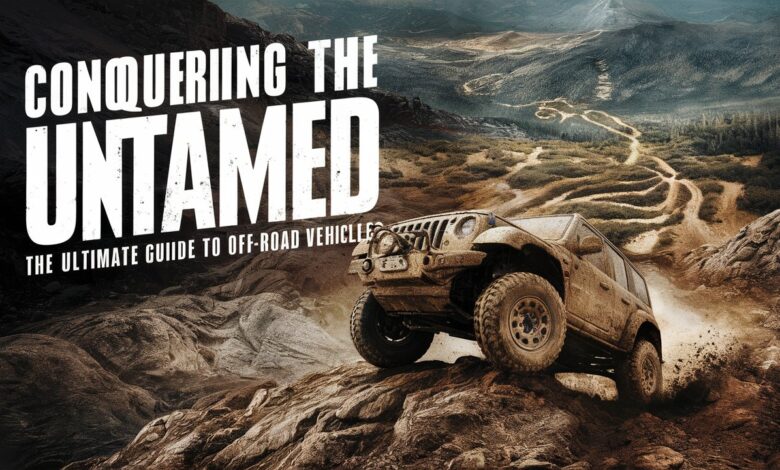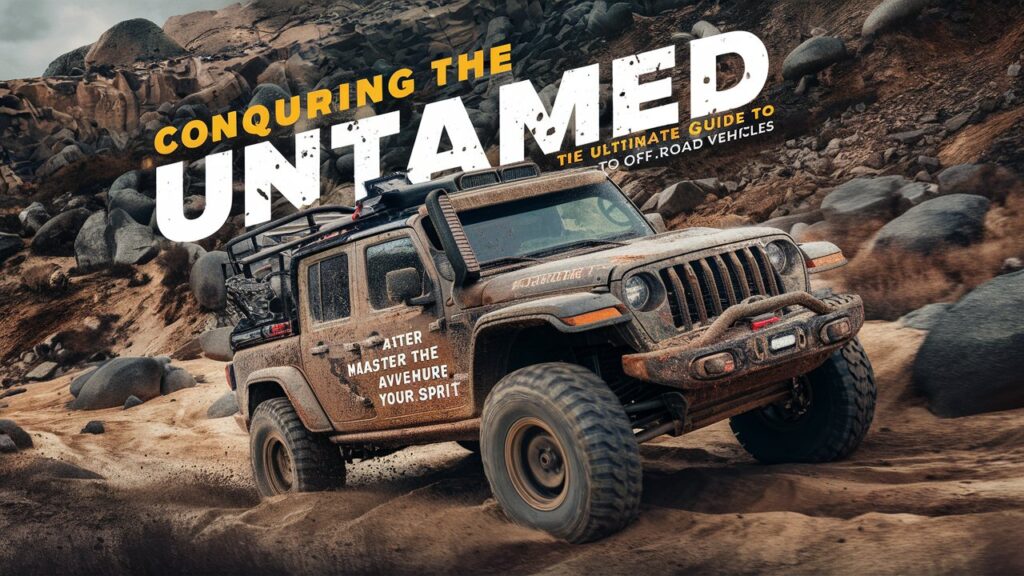
Introduction: The Allure of the Path Less Traveled
The rumble of a powerful engine, the sight of untouched landscapes stretching beyond the horizon, the exhilarating challenge of navigating terrain where pavement fears to tread – this is the captivating world of off-road vehicles. More than mere transportation, these specialized machines represent freedom, adventure, and a unique connection with the raw power of nature. They unlock remote wilderness areas, conquer daunting obstacles, and transform journeys into expeditions. From the dedicated rock crawler meticulously traversing boulder fields to the adventure-seeking family exploring forest service roads in a capable SUV, off-road vehicles cater to a diverse spectrum of enthusiasts united by a shared passion for exploration beyond the confines of conventional roads. This comprehensive guide delves into the heart of off-road machines, exploring the technologies that make them unstoppable, the diverse categories they inhabit, the essential gear that enhances the experience, and the crucial ethos of responsible adventure.
Unstoppable Traction Systems: The Foundation of Off-Road Capability
At the very core of any off-road vehicle’s ability lies its traction system. This is far more complex than simply having aggressive tires. It encompasses the entire drivetrain designed to keep the vehicle moving when surfaces become slippery, uneven, or loose. Four-Wheel Drive (4WD) and All-Wheel Drive (AWD) are the fundamental pillars, but understanding their nuances is critical. Traditional part-time 4WD systems, often found in body-on-frame trucks and SUVs, allow drivers to manually engage all four wheels when needed, typically via a transfer case lever or switch. This system provides maximum torque and durability for severe off-road use but is designed primarily for off-pavement conditions. Full-time 4WD/AWD systems power all wheels constantly, often incorporating a center differential to allow for speed variations between axles on pavement, offering seamless capability but sometimes with less extreme torque multiplication. The critical element within these systems is differential technology. Standard “open” differentials send power to the wheel with the least resistance – disastrous when one wheel is off the ground or on ice. Limited-Slip Differentials (LSDs) partially mitigate this by transferring some torque to the wheel with grip. However, the ultimate off-road traction control comes from electronic traction control systems that brake spinning wheels, and especially locking differentials (front, rear, or center). When engaged, a locking differential forces both wheels on an axle to spin at the same speed, ensuring power delivery even if one wheel has zero traction. The combination of a robust 4WD system, appropriate differential locks, and advanced electronic aids forms the bedrock of conquering challenging terrain.
Advanced Terrain Management: Navigating the Extremes
Beyond raw traction, successfully navigating diverse and unpredictable off-road environments demands sophisticated terrain management strategies. This involves both vehicle technology and driver skill. Modern off-road vehicles often feature sophisticated electronic stability control systems specifically calibrated for off-highway use. These systems go beyond basic on-road stability control by allowing for greater wheel slip before intervening, recognizing that some slippage is necessary for progress on loose surfaces. Hill Descent Control (HDC) is a crucial innovation, acting as an automated low-speed cruise control for steep downhill sections. By automatically applying the brakes to individual wheels, HDC maintains a safe, controlled descent without driver braking input, preventing wheel lock-up and potential loss of control. Hill Start Assist (HSA) prevents the vehicle from rolling backward when starting on an incline, providing crucial seconds to transition from brake to throttle. Multi-Terrain Select systems, increasingly common, allow drivers to optimize the vehicle’s throttle response, transmission shift points, traction control, and stability control for specific conditions like mud, sand, rock, or snow with the turn of a dial. Underpinning all terrain management is the vehicle’s approach angle, departure angle, breakover angle, and ground clearance – critical geometric measurements defining its ability to crest hills, descend slopes, and traverse obstacles without scraping vital components. Understanding and utilizing these technologies and measurements effectively allows drivers to adapt to the ever-changing demands of the trail.

Purpose-Built Suspension Systems: Absorbing the Punishment
The relentless punishment dished out by rocks, ruts, roots, and washboard roads demands a suspension system far more robust and capable than that of any highway cruiser. Off-road suspension systems are engineered for maximum wheel articulation – the ability of each wheel to move up and down independently – ensuring as many tires as possible maintain contact with the ground over extreme uneven terrain. This is achieved through specialized components: long-travel shock absorbers with increased stroke length, often gas-charged or remote-reservoir designs to manage heat buildup during sustained rough use; heavy-duty coil springs or progressive-rate leaf springs designed to handle significant loads and impacts without sagging or bottoming out; and performance suspension linkages like reinforced control arms and track bars. Lift kits are a common modification, increasing ground clearance and allowing for the fitment of larger tires, but they must be carefully chosen and installed to maintain proper suspension geometry and driveline angles to avoid premature wear or handling issues. Sway bar disconnects are another popular enhancement, temporarily detaching the anti-roll bar to allow for significantly increased front wheel articulation on challenging technical sections, dramatically improving traction. The suspension is the unsung hero, silently absorbing the brutal impacts that would otherwise destroy the vehicle or injure its occupants, translating a bone-jarring trail into a manageable, even comfortable, adventure.
Essential Recovery Gear and Protection: Preparing for the Inevitable
Venturing off the beaten path inherently carries the risk of becoming stuck or encountering situations beyond the vehicle’s immediate capabilities. Therefore, carrying and knowing how to use essential recovery gear is non-negotiable for responsible off-roading. The cornerstone is a robust winch, permanently mounted to the front (or rear) bumper, capable of self-recovery or assisting others. A high-quality kinetic recovery rope (like a snatch strap) is invaluable for dynamic pulls in situations like deep mud or sand where a steady winch pull might bury the vehicle deeper. Durable recovery shackles (bow shackles/D-rings) rated well beyond the vehicle’s weight are mandatory connection points. A full-size matching spare tire, a reliable jack capable of lifting the vehicle on uneven ground (like a high-lift jack, used with extreme caution, or a quality bottle jack with a base plate), and basic tire repair kit are fundamental. Beyond recovery, vehicle protection is paramount. Skid plates shielding the engine oil pan, transmission, transfer case, and fuel tank from rock impacts are essential armor. Rock sliders protect vulnerable rocker panels and doors from damage when sliding over obstacles or against rocks. Heavy-duty bumpers, often incorporating winch mounts and improved approach/departure angles, replace fragile factory units. Carrying comprehensive communication equipment (satellite messengers beyond cell range) and a well-stocked first-aid kit rounds out the essential preparedness mindset.
Exploring the Diverse World of Off-Road Vehicle Categories
The term “off-road vehicle” encompasses a remarkably diverse range of machines, each engineered with specific terrains and purposes in mind. Understanding these categories helps enthusiasts choose the right tool for their adventure:
- 4×4 Trucks & SUVs: The most versatile category, ranging from moderately capable family SUVs with AWD to highly modified dedicated trail rigs. Body-on-frame construction offers inherent strength and durability. Examples include the Jeep Wrangler, Toyota Land Cruiser/Lexus LX, Ford Bronco, Chevrolet Colorado ZR2, and Toyota Tacoma/4Runner TRD Pro. These offer passenger and cargo space alongside serious capability.
- All-Terrain Vehicles (ATVs): Also known as “quads,” these nimble, single-rider machines excel in trail riding, farm work, and dune running. Their light weight and agility make them perfect for navigating tight trails inaccessible to larger vehicles.
- Utility Terrain Vehicles (UTVs/Side-by-Sides – SxS): These multi-passenger (usually 2-6 seat) vehicles offer a blend of ATV agility and near-truck utility. Features like roll cages, seat belts, cargo beds, and powerful engines make them immensely popular for recreation, racing (like desert or rock crawling), and work applications. Brands like Polaris RZR, Can-Am Maverick, and Yamaha YXZ dominate.
- Dirt Bikes & Dual-Sport Motorcycles: The ultimate in lightweight off-road agility for single riders. Dirt bikes are pure off-road competition machines, while dual-sport bikes are street-legal versions equipped for both highway and trail riding, offering unparalleled access.
- Overlanding Vehicles: Less a specific vehicle type and more a purpose-built application. These are typically modified 4×4 trucks or SUVs equipped for self-sufficient, long-duration travel through remote areas. They feature extensive camping gear storage (roof top tents, drawer systems), enhanced power systems (solar, auxiliary batteries), water storage, and communications, prioritizing reliability and endurance over extreme rock-crawling prowess.
Conclusion: Embracing Adventure with Respect and Responsibility
Off-road vehicles are powerful keys unlocking experiences inaccessible by conventional means. They foster camaraderie, challenge our skills, and immerse us in the breathtaking beauty of the natural world. However, this privilege comes with significant responsibility. Adhering to Tread Lightly! principles – Travel responsibly, Respect the rights of others, Educate yourself, Avoid sensitive areas, and Do your part – is essential to preserving trails and ecosystems for future generations. Staying on designated routes, minimizing noise and dust, packing out all trash (including human waste when necessary), and respecting wildlife and private property are fundamental tenets of the off-road community. Mastering the capabilities of your vehicle through practice and training, carrying and knowing how to use essential recovery and safety gear, and venturing out prepared for changing conditions are all part of the responsible adventure equation. By embracing both the exhilarating freedom and the profound responsibility that off-roading entails, enthusiasts can ensure that the call of the wild remains a sustainable and rewarding pursuit for years to come.
Frequently Asked Questions (FAQs)
- What’s the difference between 4WD and AWD?
- 4WD (Four-Wheel Drive): Typically a system designed for serious off-road use, often with a transfer case allowing drivers to manually select between 2WD (for better fuel economy on pavement) and 4WD High or Low range. 4WD Low provides maximum torque multiplication for crawling over extreme obstacles or steep grades. Systems can be part-time (only for off-pavement) or full-time. Generally features more robust components.
- AWD (All-Wheel Drive): Primarily designed for enhanced on-road traction in slippery conditions (rain, snow, light gravel). It powers all wheels constantly using a center differential. Most AWD systems operate automatically and lack a dedicated low-range gear. While some modern AWD systems are very capable (“all-road”), they are generally not built for sustained, severe rock crawling or deep mud like dedicated 4WD systems.
- Do I need locking differentials?
- Locking differentials (especially a rear locker) are incredibly valuable for serious off-roading. They provide maximum traction when one wheel on an axle loses grip (e.g., lifted off the ground or on ice). While advanced electronic traction control can compensate significantly, a mechanical locker provides more consistent, predictable power delivery in the most extreme situations. For moderate trails, you might manage without, but for rocks, deep ruts, or challenging climbs/descents, lockers are a major advantage.
- What are the most important modifications for a beginner?
- Tires: The single most impactful upgrade. Invest in high-quality All-Terrain (A/T) or Mud-Terrain (M/T) tires appropriate for your most common terrain. Ensure they are the correct load rating.
- Recovery Points: Install rated front and rear recovery points (shackle mounts or D-rings) BEFORE you need them. Factory tie-downs are often insufficient.
- Recovery Gear: At minimum, carry a kinetic recovery rope (snatch strap), 2-3 rated recovery shackles, gloves, and a basic shovel.
- Skid Plates: Protect vital underbody components (engine, transmission, fuel tank) from rock damage.
- Is off-roading bad for the environment?
- Off-roading can be damaging if done irresponsibly. Creating new trails, driving off designated routes (especially in sensitive habitats like wetlands or deserts), causing excessive erosion, disturbing wildlife, or leaving trash all have negative impacts. However, responsible off-roading – staying strictly on established trails, minimizing speed and wheel spin to reduce erosion and dust, packing out everything you pack in, respecting seasonal closures, and adhering to “Tread Lightly!” principles – minimizes environmental impact. Many off-road clubs actively participate in trail maintenance and conservation efforts.
- How do I find legal off-road trails?
- Research is key! Utilize resources from:
- Land Management Agencies: Bureau of Land Management (BLM), US Forest Service (USFS), National Park Service (NPS – very limited off-roading), State Parks, State Department of Natural Resources (DNR). Check their websites for Motor Vehicle Use Maps (MVUMs) which show designated roads and trails open to specific vehicle types.
- Local Off-Road Clubs: Clubs are invaluable sources of local trail knowledge, events, and responsible riding practices.
- Apps & Websites: Dedicated off-road trail mapping apps and websites (like OnX Offroad, Trails Offroad, Gaia GPS with appropriate layers) provide detailed, frequently updated trail information, including difficulty ratings and legal status. Never assume a trail is open; always verify with official sources.
- Research is key! Utilize resources from:



